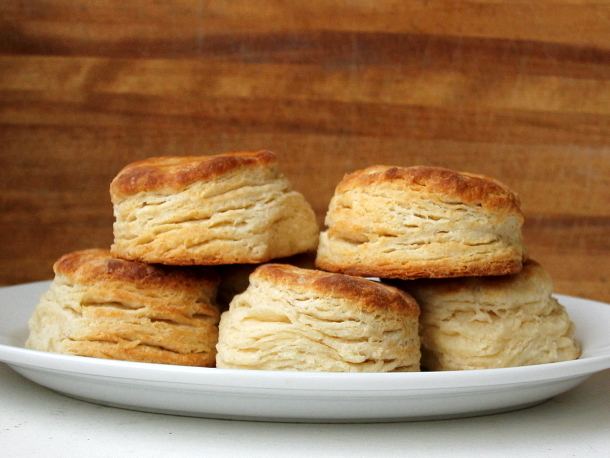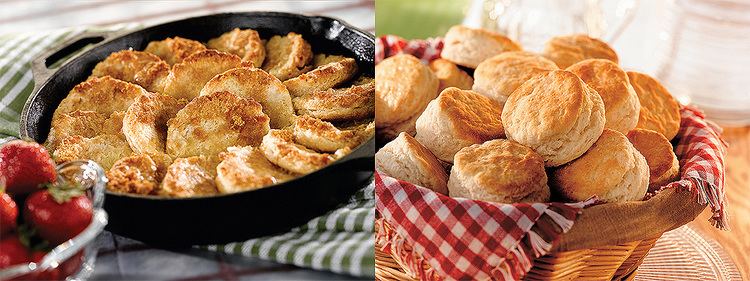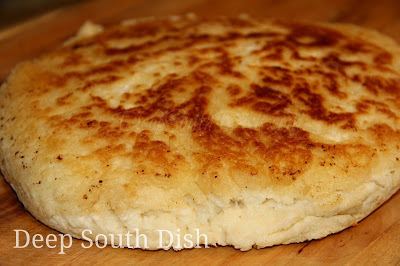Type Bread | ||
 | ||
Main ingredients Flour, baking powder or baking soda Similar Biscuits and gravy, Buttermilk, Gravy, Cornbread, Cheddar cheese | ||
A biscuit in the United States and parts of Canada, and widely used in popular American English, is a small baked good with a firm browned crust and a soft interior. They are made with baking powder or baking soda as a chemical leavening agent rather than yeast. They are similar to British scones or the bannock from the Shetland Isles.
Contents

Biscuits, soda breads, and cornbread, among others, are often referred to collectively as "quick breads," to indicate that they do not need time to rise before baking.

Earlier history

Although the American English and British English use the same word to refer to two distinctly different modern foods, early hard biscuits (North American: cookies), were derived from or as a storable version of bread. The word "biscuit" itself originates from the medieval Latin word 'biscoctus', meaning "twice-cooked."

The modern Italian baked goods known as biscotti (also meaning "twice-cooked" in Italian) most closely resemble the Medieval Latin item and cooking technique.

In the Hispanic world a bizcocho refers to an array of differing baked goods depending on the country, from Spain and throughout Hispanic America. In the Philippines, a biskotso (also spelled "biscocho"), derived from a word used by the Spanish conquerors, refers to a type of garlic bread.
The one common feature between all varieties worldwide is that they require some form of baking.

The definitive explanation for the differences in the usage of "biscuit" in the English speaking world is provided by Elizabeth David in English Bread and Yeast Cookery, in the chapter "Yeast Buns and Small Tea Cakes" and section "Soft Biscuits". She writes,
It is interesting that these soft biscuits are common to Scotland and Guernsey, and that the term biscuit as applied to a soft product was retained in these places, and in America, whereas in England it has completely died out.
Early European settlers in the United States brought with them a simple, easy style of cooking, most often based on ground wheat and warmed with gravy.
The biscuit emerged as a distinct food type in the early 19th century, before the American Civil War. Cooks created a cheaply produced addition for their meals that required no yeast, which was expensive and difficult to store. With no leavening agents except the bitter-tasting pearlash available, beaten biscuits were laboriously beaten and folded to incorporate air into the dough which expanded when heated in the oven causing the biscuit to rise. In eating, the advantage of the biscuit over a slice of bread was that it was harder, and hence kept its shape when wiping up gravy in the popular combination biscuits and gravy.
In 1875, Alexander P. Ashbourne patented the first biscuit cutter. It consisted of a board to roll the biscuits out on, which was hinged to a metal plate with various biscuit cutter shapes mounted to it.
Later history
Southern chefs may have had an advantage in creating biscuits. Northern American all-purpose flours, mainly grown in Ohio, Indiana and Illinois, are made from the hard spring wheats, that grow in a cold winter climate. Southern American bleached all-purpose flours, originally grown in the Carolinas, Georgia and Tennessee before national food distribution networks, are made from the soft winter wheat that grows in the warm southern summer. This summer growth results in wheat that has less protein, which is more suited to the creation of quick breads, as well as cookies, cakes and muffins.
Pre-shaped ready-to-bake biscuits can be purchased in supermarkets, in the form of small refrigerated cylindrical segments of dough encased in a cardboard can. These refrigerator biscuits were patented by Ballard and Ballard in 1931.
Cooking
Biscuits can be prepared for baking in several ways. The dough can be rolled out flat and cut into rounds, which expand when baked into flaky-layered cylinders. If extra liquid is added, the dough's texture changes to resemble stiff pancake batter so that small spoonfuls can be dropped into the baking sheet to produce "drop biscuits," which are more amorphous in texture and shape.
Large drop biscuits, because of their size and rough exterior texture, are sometimes referred to as "cat head biscuits." A common variation on basic biscuits is "cheese biscuits," made by adding grated Cheddar or American cheese to the basic recipe.
Home cooks may use refrigerator biscuits for a quicker alternative to rolled or drop biscuits. Refrigerator biscuits can even be cooked over a campfire on a stick.
A sweet biscuit layered or topped with fruit (typically strawberries), juice-based syrup, and cream is called shortcake. A type of biscuit called an "angel biscuit" contains yeast as well, as do those made with a sourdough starter. In Canada, both sweet and savory are referred to as "biscuits," "baking powder biscuits," or "tea biscuits," although "scone" is also starting to be used.
While there are many different ways to prepare and top biscuits, the ingredients from recipe to recipe are generally the same. Most recipes will call for all-purpose flour, baking powder, salt, milk, and either butter or shortening (about half will also call for a small amount of sugar as
well). The amount of each ingredient will vary for each recipe much the general concept is the same for these simple baked goods.
